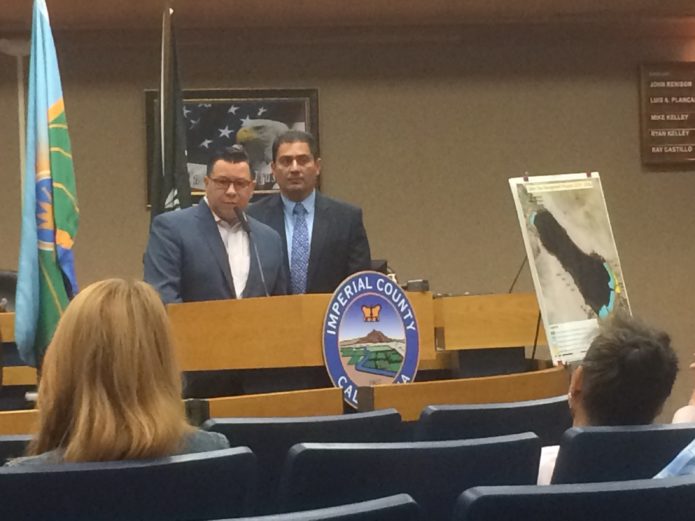
Assemblyman Eduardo Garcia (left) and Sen. Ben Hueso discuss the passage of Prop. 68 and what it means for the Salton Sea during a press conference held Friday, June 29, at the Imperial County Board of Supervisors’ chambers. The proposition provides $200 million toward the state’s Salton Sea restoration program.
State Sen. Ben Hueso and Assemblyman Eduardo Garcia marked the passage of Proposition 68 and what it means for the Salton Sea during a joint press conference Friday, June 29, at the Imperial County Board of Supervisors chambers. Joined by Bruce Wilcox, assistant secretary of California Natural Resources in charge of Salton Sea policy, the two state legislative leaders noted that the state is committed to funding restoration efforts to address the sea.
During the hour-long press conference, Hueso, who represents San Diego and Imperial counties, thanked voters for passing Prop. 68, which includes $200 million for the Salton Sea. According to Garcia, who represents Riverside and Imperial counties, $170 million of that funding is for the state to implement its phased restoration program, called the Salton Sea Management Program (SSMP), and $30 million is for the Salton Sea Authority, which is working with the state on the restoration effort. Of the $30 million, $10 million is earmarked for the cleanup of the New River, one of the main tributaries which flows from Mexico, through the Imperial Valley, and into the sea.
Garcia also spoke of additional funding that could help the restoration effort. In November, California voters will be asked to support another water bond that would provide an additional $200 million for the sea. Additionally, Garcia stated there are provisions that if other projects funded by Prop. 68 do not come to fruition, the Salton Sea could see an additional outlay of funding—as much as another $200 million. Garcia said it is realistic to think that by year’s end, the Sea could have up to a total of almost $600 million in State funding to implement the SSMP.
Hueso spoke of legislation he has introduced to create a local authority with broader directions to restore the sea and of public and private partnerships that could further help advance Salton Sea restoration.
“The area around the sea can be a very healthy place to live,” Hueso said. “That is our goal.”
Garcia said the first ten years of the state’s SSMP has two very focused goals— (1) to address public health and (2) the ecological system. Steps are being taken to achieve these points. Garcia said he is also working with legislation to advance the development of geothermal energy in California with the Salton Sea as a center for such renewable energy., The idea is that geothermal development can be a piece of the restoration program.
“The ball is moving down the court,” Garcia said, adding: “The idea nothing is happening is not factual.”
Bruce Wilcox said with the passage of Prop. 68, he is more optimistic about the sea than he has been in years. He said the SSMP is a coordinated program with projects now moving ahead. He added the SSMP is a program that can be subject to change based on public input, adding that in September there will be a new round of public meetings to share information and receive input on the SSMP.
In regard to the 11 proposals submitted to the state to import water to the sea, Wilcox said a selection committee will be reviewing them to determine which ones will move forward to another phase of consideration. The proposals involve importing water from The Sea of Cortez to the Salton Sea, which state officials say could represent a long-term solution. However, the state continues to say the focus currently has to be on working to address the immediate air quality and habitat needs for the sea and surrounding communities.
Based on hydrological studies, the Salton Sea is anticipated to have about 750,000 acre-feet of inflow going forward. Most of that water comes from agricultural run-off from the Imperial Valley through the New and Alamo rivers and from inflows from the White River in Riverside County. While that does not represent a water right for the sea and the amount of inflows can change year to year, that still represents a large amount of water to address restoration.
Stay tuned for more to come.
